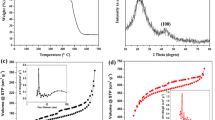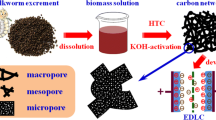Abstract
To achieve a higher energy density for the supercapacitor without degrading cycle stability, functionalization of biomass based-AC with oxygen-containing groups was applied. Nanostructured carbon materials were produced from barley straw biomass waste using the activation-functionalization by FeCl3 and urea via the pyrolysis method in a tubular reactor at 900 °C. The electrode made up of carbon BCF-U in the three-electrode cell in aqueous KOH electrolyte showed high-specific capacitance of 515 F g–1 at current density of 2 A g−1 and in aqueous Na2SO4 electrolyte the capacitance of 379 F g−1 at 3 A g−1. The BCF-U electrode showed cycling stability, retaining more than 99% capacitance after 5000 cycles in 1 M Na2SO4 electrolyte. The fabricated symmetric supercapacitor device with carbon BCF-U showed a high-energy density of 10.7 Wh kg–1 and a power density of 720 W kg−1 in aqueous 6 M KOH. Different characterizations were carried out to show that the functional group and morphological features of the activated carbon were closely related to the superior capacitive performance by enhancing diffusion of electrolyte ions. The analysis proved the formation of graphitic nature with mixed micro- and mesoporous textures in addition to carbon nanotube, carbon nano rod, and graphene. These unique features make synthetic activated and functionalized samples possess good adsorption capacity for electrical double layer capacitors. The results demonstrate that nanostructured carbon materials derived from a low-cost biomass waste can serve as an economical carbon feedstock for production of high-performance electrode material for supercapacitors.
Graphical abstract















Similar content being viewed by others
Availability of data and materials
Not applicable.
References
Okolie JA, Nanda S, Dalai AK et al (2021) Chemistry and specialty industrial applications of lignocellulosic biomass. Waste Biomass Valorization 12:2145–2169
Agu OS, Tabil LG, Dumonceaux T (2017) Microwave-assisted alkali pre-treatment, densification and enzymatic saccharification of canola straw and oat hull. Bioengineering 4:25
Lawrinenko M, Wang Z, Horton R et al (2017) Macroporous carbon supported zerovalent iron for remediation of trichloroethylene. ACS Sustain Chem Eng 5:1586–1593
Mohammed NA, Abu-Zurayk RA, Hamadneh I et al (2018) Phenol adsorption on biochar prepared from the pine fruit shells: equilibrium, kinetic and thermodynamics studies. J Environ Manage 226:377–385
Stein A, Wang Z, Fierke MA (2009) Functionalization of porous carbon materials with designed pore architecture. Adv Mater 21:265–293
Saini S, Chand P, Joshi A (2021) Biomass derived carbon for supercapacitor applications. J Energy Storage 39:102646
Zhang Y-Z, Wang Y, Cheng T et al (2019) Printed supercapacitors: materials, printing and applications. Chem Soc Rev 48:3229–3264
Yu G, Xie X, Pan L et al (2013) Hybrid nanostructured materials for high-performance electrochemical capacitors. Nano Energy 2:213–234
Muzaffar A, Ahamed MB, Deshmukh K et al (2019) A review on recent advances in hybrid supercapacitors: design, fabrication and applications. Renew Sustain Energy Rev 101:123–145
Zhou J, Jiang L, Shu C et al (2021) A universal strategy for N-doped 2D carbon nanosheets with sub-nanometer micropore for high-performance supercapacitor. Energy Environ Mater 4:569–576
Zhou J, Zhang S, Zhou Y-N et al (2021) Biomass-derived carbon materials for high-performance supercapacitors: current status and perspective. Electrochem Energy Rev 4:219–248
Cheng L, Guo P, Wang R et al (2014) Electrocapacitive properties of supercapacitors based on hierarchical porous carbons from chestnut shell. Colloids Surf A Physicochem Eng Asp 446:127–133
Cao Y, Wang K, Wang X et al (2016) Hierarchical porous activated carbon for supercapacitor derived from corn stalk core by potassium hydroxide activation. Electrochim Acta 212:839–847
Chen Z, Wang X, Xue B et al (2019) Self-templating synthesis of 3D hollow tubular porous carbon derived from straw cellulose waste with excellent performance for supercapacitors. ChemSusChem 12:1390–1400
Yakaboylu GA, Yumak T, Jiang C et al (2019) Preparation of highly porous carbon through slow oxidative torrefaction, pyrolysis, and chemical activation of lignocellulosic biomass for high-performance supercapacitors. Energy Fuels 33:9309–9329
Lin G, Wang Q, Yang X et al (2020) Preparation of phosphorus-doped porous carbon for high performance supercapacitors by one-step carbonization. RSC Adv 10:17768–17776
Li M, Han K, Teng Z et al (2020) Comparison of porous carbons derived from sodium alginate and calcium alginate and their electrochemical properties. RSC Adv 10:2209–2215
Hulicova-Jurcakova D, Seredych M, Lu GQ et al (2009) Combined effect of nitrogen-and oxygen-containing functional groups of microporous activated carbon on its electrochemical performance in supercapacitors. Adv Func Mater 19:438–447
Li X, Xing W, Zhuo S et al (2011) Preparation of capacitor’s electrode from sunflower seed shell. Biores Technol 102:1118–1123
Conway BE (1999) Electrochemical supercapacitors
Xia L, Yu L, Hu D et al (2017) Electrolytes for electrochemical energy storage. Mater Chem Front 1:584–618
Zeiger M, Jäckel N, Mochalin VN et al (2016) carbon onions for electrochemical energy storage. J Mater Chem A 4:3172–3196
Cameán I, Lavela P, Tirado JL et al (2010) On the electrochemical performance of anthracite-based graphite materials as anodes in lithium-ion batteries. Fuel 89:986–991
Kim YJ, Abe Y, Yanagiura T et al (2007) Easy preparation of nitrogen-enriched carbon materials from peptides of silk fibroins and their use to produce a high volumetric energy density in supercapacitors. Carbon 45:2116–2125
Qu D, Shi H (1998) Studies of activated carbons used in double-layer capacitors. J Power Sources 74:99–107
Zhao W, Zhang H, Liu J et al (2018) Controlled air-etching synthesis of porous-carbon nanotube aerogels with ultrafast charging at 1000 A g− 1. Small 14:1802394
FAO F (2018) Food and agriculture organization of the United Nations. Rome. http://faostat.fao.org
Houshyar E (2017) Environmental impacts of irrigated and rain-fed barley production in Iran using life cycle assessment (LCA). Span J Agric Res 15:e0204–e0204
Hou J, Cao C, Idrees F et al (2015) Hierarchical porous nitrogen-doped carbon nanosheets derived from silk for ultrahigh-capacity battery anodes and supercapacitors. ACS Nano 9:2556–2564
Zapata-Benabithe Z, Carrasco-Marín F, Moreno-Castilla C (2012) Preparation, surface characteristics, and electrochemical double-layer capacitance of KOH-activated carbon aerogels and their O-and N-doped derivatives. J Power Sources 219:80–88
Nataraj S, Kim B, dela Cruz M et al (2009) Free standing thin webs of porous carbon nanofibers of polyacrylonitrile containing iron-oxide by electrospinning. Mater Lett 63:218–220
Galarneau A, Mehlhorn D, Guenneau F et al (2018) Specific surface area determination for microporous/mesoporous materials: the case of mesoporous FAU-Y zeolites. Langmuir 34:14134–14142
Wei S, Zhang H, Huang Y et al (2011) Pig bone derived hierarchical porous carbon and its enhanced cycling performance of lithium–sulfur batteries. Energy Environ Sci 4:736–740
Fuertes AB, Sevilla M (2015) Hierarchical microporous/mesoporous carbon nanosheets for high-performance supercapacitors. ACS Appl Mater Interfaces 7:4344–4353
Hou PX, Zhang F, Zhang L et al (2022) Synthesis of carbon nanotubes by floating catalyst chemical vapor deposition and their applications. Adv Func Mater 32:2108541
Han F, Qian L, Wu Q et al (2022) Narrow-chirality distributed single-walled carbon nanotube synthesized from oxide promoted Fe–SiC catalyst. Carbon 191:146–152
Qiu T, Yang J-G, Bai X-J et al (2019) The preparation of synthetic graphite materials with hierarchical pores from lignite by one-step impregnation and their characterization as dye absorbents. RSC Adv 9:12737–12746
Qie L, Chen WM, Wang ZH et al (2012) Nitrogen-doped porous carbon nanofiber webs as anodes for lithium ion batteries with a superhigh capacity and rate capability. Adv Mater 24:2047–2050
Sadezky A, Muckenhuber H, Grothe H et al (2005) Raman microspectroscopy of soot and related carbonaceous materials: spectral analysis and structural information. Carbon 43:1731–1742
Wang Y, Alsmeyer DC, McCreery RL (1990) Raman spectroscopy of carbon materials: structural basis of observed spectra. Chem Mater 2:557–563
Delhaes P, Couzi M, Trinquecoste M et al (2006) A comparison between Raman spectroscopy and surface characterizations of multiwall carbon nanotubes. Carbon 44:3005–3013
Zhao C, Jiang E, Chen A (2017) Volatile production from pyrolysis of cellulose, hemicellulose and lignin. J Energy Inst 90:902–913
Gerber I, Oubenali M, Bacsa R et al (2011) Theoretical and experimental studies on the carbon-nanotube surface oxidation by nitric acid: interplay between functionalization and vacancy enlargement. Chem Eur J 17:11467–11477
Xu B, Zheng D, Jia M et al (2013) Nitrogen-doped porous carbon simply prepared by pyrolyzing a nitrogen-containing organic salt for supercapacitors. Electrochim Acta 98:176–182
Zhao Z, Wang Y, Li M et al (2015) High performance N-doped porous activated carbon based on chicken feather for supercapacitors and CO 2 capture. RSC Adv 5:34803–34811
Liu H, Song H, Chen X et al (2015) Effects of nitrogen-and oxygen-containing functional groups of activated carbon nanotubes on the electrochemical performance in supercapacitors. J Power Sources 285:303–309
Frackowiak E, Beguin F (2001) Carbon materials for the electrochemical storage of energy in capacitors. Carbon 39:937–950
Fang Y, Luo B, Jia Y et al (2012) Renewing functionalized graphene as electrodes for high-performance supercapacitors. Adv Mater 24:6348–6355
Fletcher S, Black VJ, Kirkpatrick I (2014) A universal equivalent circuit for carbon-based supercapacitors. J Solid State Electrochem 18:1377–1387
Kim BK, Sy S, Yu A et al (2015) Handbook of clean energy systems. Wiley Online Library
Jiang Y, Liu J (2019) Definitions of pseudocapacitive materials: a brief review. Energy Environ Mater 2:30–37
Raymundo-Piñero E, Leroux F, Béguin F (2006) A high-performance carbon for supercapacitors obtained by carbonization of a seaweed biopolymer. Adv Mater 18:1877–1882
Zhu Y, Murali S, Stoller MD et al (2011) Carbon-based supercapacitors produced by activation of graphene. Science 332:1537–1541
Adib F, Bagreev A, Bandosz TJ (2000) Analysis of the relationship between H2S removal capacity and surface properties of unimpregnated activated carbons. Environ Sci Technol 34:686–692
Raymundo-Piñero E, Cadek M, Béguin F (2009) Tuning carbon materials for supercapacitors by direct pyrolysis of seaweeds. Adv Func Mater 19:1032–1039
Montes-Morán M, Suárez D, Menéndez J et al (2004) On the nature of basic sites on carbon surfaces: an overview. Carbon 42:1219–1225
Andreas HA, Conway BE (2006) Examination of the double-layer capacitance of an high specific-area C-cloth electrode as titrated from acidic to alkaline pHs. Electrochim Acta 51:6510–6520
Huang J, Liang Y, Hu H et al (2017) Ultrahigh-surface-area hierarchical porous carbon from chitosan: acetic acid mediated efficient synthesis and its application in superior supercapacitors. J Mater Chem A 5:24775–24781
Zhang J, Coffinier Y, Zhao Z-Y et al (2020) Preparation of boron-doped diamond nanospikes on porous Ti substrate for high-performance supercapacitors. Electrochim Acta 354:136649
Su Y-S, Manthiram A (2012) Lithium–sulphur batteries with a microporous carbon paper as a bifunctional interlayer. Nat Commun 3:1–6
Chmiola J, Yushin G, Gogotsi Y et al (2006) Anomalous increase in carbon capacitance at pore sizes less than 1 nanometer. Science 313:1760–1763
Raymundo-Pinero E, Kierzek K, Machnikowski J et al (2006) Relationship between the nanoporous texture of activated carbons and their capacitance properties in different electrolytes. Carbon 44:2498–2507
Seredych M, Hulicova-Jurcakova D, Lu GQ et al (2008) Surface functional groups of carbons and the effects of their chemical character, density and accessibility to ions on electrochemical performance. Carbon 46:1475–1488
Simon P, Gogotsi Y (2008) Materials for electrochemical capacitors. Nat Mater 7:845–854
Zhu J, Xu Y, Wang J et al (2015) The effect of various electrolyte cations on electrochemical performance of polypyrrole/RGO based supercapacitors. Phys Chem Chem Phys 17:28666–28673
Fic K, Lota G, Meller M et al (2012) Novel insight into neutral medium as electrolyte for high-voltage supercapacitors. Energy Environ Sci 5:5842–5850
Wu H, Wang X, Jiang L et al (2013) The effects of electrolyte on the supercapacitive performance of activated calcium carbide-derived carbon. J Power Sources 226:202–209
Bhattarai JK, Tan YH, Pandey B et al (2016) Electrochemical impedance spectroscopy study of Concanavalin A binding to self-assembled monolayers of mannosides on gold wire electrodes. J Electroanal Chem 780:311–320
He X, Geng Y, Qiu J et al (2010) Effect of activation time on the properties of activated carbons prepared by microwave-assisted activation for electric double layer capacitors. Carbon 48:1662–1669
Ershadi M, Javanbakht M, Mozaffari SA et al (2020) Facile stitching of graphene oxide nanosheets with ethylenediamine as three dimensional anode material for lithium-ion battery. J Alloy Compd 818:152912
Hsieh C-T, Hsu S-M, Lin J-Y et al (2011) Electrochemical capacitors based on graphene oxide sheets using different aqueous electrolytes. J Phys Chem C 115:12367–12374
Wang Y, Shi Z, Huang Y et al (2009) Supercapacitor devices based on graphene materials. J Phys Chem C 113:13103–13107
Tang Y, Chen T, Yu S et al (2015) A highly electronic conductive cobalt nickel sulphide dendrite/quasi-spherical nanocomposite for a supercapacitor electrode with ultrahigh areal specific capacitance. J Power Sources 295:314–322
Xu Z, Zhang X, Liang Y et al (2020) Green synthesis of nitrogen-doped porous carbon derived from rice straw for high-performance supercapacitor application. Energy Fuels 34:8966–8976
Li M, Xiao H, Zhang T et al (2019) Activated carbon fiber derived from sisal with large specific surface area for high-performance supercapacitors. ACS Sustain Chem Eng 7:4716–4723
Rajabathar JR, Sivachidambaram M, Vijaya JJ et al (2020) Flexible type symmetric supercapacitor electrode fabrication using phosphoric acid-activated carbon nanomaterials derived from cow dung for renewable energy applications. ACS Omega 5:15028–15038
Guan L, Pan L, Peng T et al (2019) Synthesis of biomass-derived nitrogen-doped porous carbon nanosheests for high-performance supercapacitors. ACS Sustain Chem Eng 7:8405–8412
Hao Z-Q, Cao J-P, Dang Y-L et al (2019) Three-dimensional hierarchical porous carbon with high oxygen content derived from organic waste liquid with superior electric double layer performance. ACS Sustain Chem Eng 7:4037–4046
Sun N, Li Z, Zhang X et al (2019) Hierarchical porous carbon materials derived from kelp for superior capacitive applications. ACS Sustain Chem Eng 7:8735–8743
Ban C-L, Xu Z, Wang D et al (2019) Porous layered carbon with interconnected pore structure derived from reed membranes for supercapacitors. ACS Sustain Chem Eng 7:10742–10750
Ding Y, Le Mo, Gao C et al (2018) High-surface-area porous carbon flakes derived from boat-fruited sterculia seeds for high-energy-density aqueous symmetric supercapacitors. ACS Sustain Chem Eng 6:9822–9830
Chen Z, Zhuo H, Hu Y et al (2018) Self-biotemplate preparation of hierarchical porous carbon with rational mesopore ratio and high oxygen content for an ultrahigh energy-density supercapacitor. ACS Sustain Chem Eng 6:7138–7150
Du J, Liu L, Hu Z et al (2018) Raw-cotton-derived N-doped carbon fiber aerogel as an efficient electrode for electrochemical capacitors. ACS Sustain Chem Eng 6:4008–4015
Yu P, Liang Y, Dong H et al (2018) Rational synthesis of highly porous carbon from waste bagasse for advanced supercapacitor application. ACS Sustain Chem Eng 6:15325–15332
You X, Misra M, Gregori S et al (2018) Preparation of an electric double layer capacitor (EDLC) using Miscanthus-derived biocarbon. ACS Sustain Chem Eng 6:318–324
Acknowledgements
The authors are grateful for financial support of this study by the Amirkabir University of Technology (Tehran Polytechnic).
Funding
This research is not funded by a specific project grant.
Author information
Authors and Affiliations
Contributions
Mehrnaz Ebrahimi carried out the experiments and wrote the manuscript–original draft. Hassan Hosseini-Monfared verified the results, supervised the project, and wrote the manuscript–original draft. Mehran Javanbakht advised and reviewed the article. Mehrnaz Ebrahimi and Fatemeh Mahdi carried out the electrochemical analysis. The authors read and approved the final manuscript.
Corresponding author
Ethics declarations
Ethical approval
Not applicable.
Conflict of interest
The authors declare that they have no competing interests.
Additional information
Publisher's note
Springer Nature remains neutral with regard to jurisdictional claims in published maps and institutional affiliations.
Supplementary information
Below is the link to the electronic supplementary material.
Rights and permissions
Springer Nature or its licensor (e.g. a society or other partner) holds exclusive rights to this article under a publishing agreement with the author(s) or other rightsholder(s); author self-archiving of the accepted manuscript version of this article is solely governed by the terms of such publishing agreement and applicable law.
About this article
Cite this article
Ebrahimi, M., Hosseini-Monfared, H., Javanbakht, M. et al. Biomass-derived nanostructured carbon materials for high-performance supercapacitor electrodes. Biomass Conv. Bioref. (2023). https://doi.org/10.1007/s13399-022-03733-1
Received:
Revised:
Accepted:
Published:
DOI: https://doi.org/10.1007/s13399-022-03733-1




